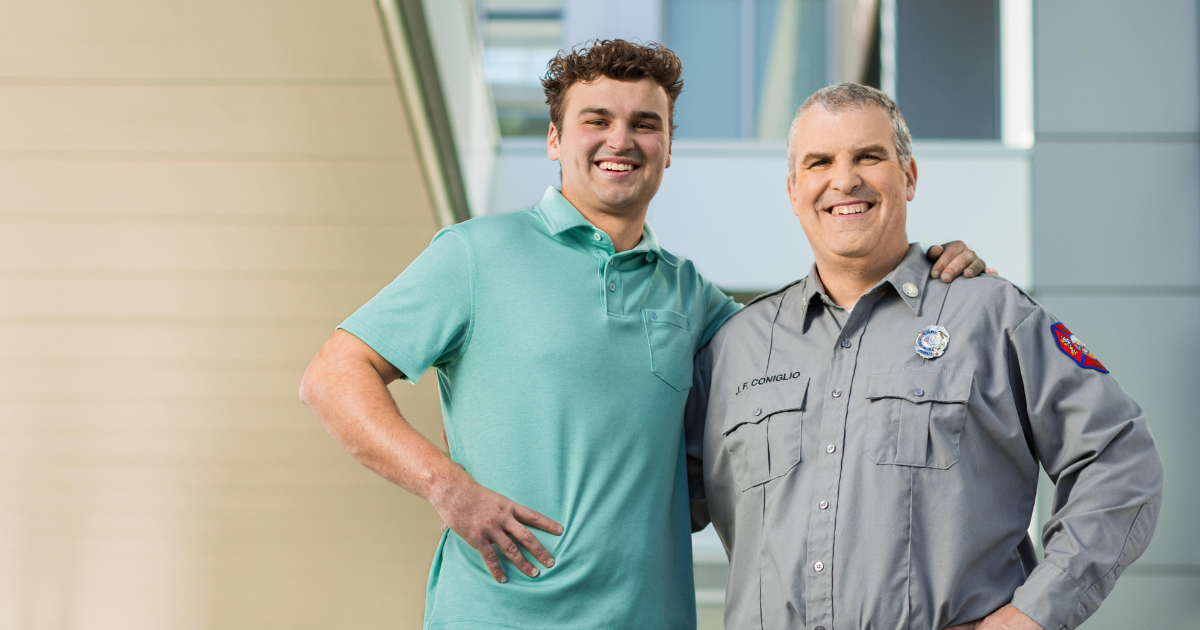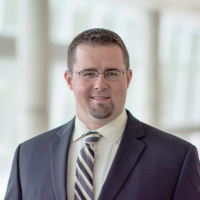'Stars aligned' for fire captain who survived massive heart attack

As an Omaha firefighter for over two decades, John Coniglio has seen CPR and early intervention save lives. What he didn’t know before June 1, 2022, was that they would save his own life.
John, 51, suffered a massive heart attack on that day. However, his first memory of the time is five days later, when he awoke in a hospital bed with his wife, Shelly, and mother, Katherine, praying over him.
“I remember them saying the rosary, and someone came in and said, ‘I’m going to take this tube out,’” he says. “Once that happened, I remember looking up, saying, ‘What happened?’”
Shelly walked him through the events of the last several days, and only then did he realize he had survived what easily could have been a fatal event. From the lifesaving CPR performed by his son to the swift expertise of paramedics, doctors and staff, John’s story shows how each step of the emergency response can make the difference between life and death.
The collapse
On that June day, he and his 22-year-old son, John, were tearing out carpet in their family home when the elder John’s jaw and back began to hurt. Soon after, young John heard his dad fall on the stairs. He called out to him but was met with silence.
In the meantime, John’s daughter, Ava, 18, found him lying on the stairs. Young John raced to them and told Ava to call 911. Initially, he thought his dad injured himself falling, but he quickly realized it was more serious.
“He started choking on his saliva like he was trying to talk,” young John says. “And then he kind of lifted his arms up, and I like to think he saw my grandpa, who had died not long before, and that he saved him.”
The elder John became unresponsive, so his son started CPR. He drew on lifeguard training he received years earlier and an episode of “The Office,” in which staff perform CPR on a dummy to the tempo of “Stayin’ Alive” by the BeeGees.
Within three minutes, paramedics arrived and took over. They couldn’t find a pulse, so they shocked John with a defibrillator, hooked him up to a CPR device and transferred him to an ambulance.
At Nebraska Medical Center
When John arrived in the Emergency Department, he couldn’t have been in better hands. He was met by the trauma team and Eric Ernest, MD, division chief of Emergency Medical Services, who also serves as the assistant medical director for the Omaha Fire Department.

“Because he had been exerting himself before his fall, I had a high clinical suspicion that this was cardiac in origin,” says Dr. Ernest. “We got a pulse back and quickly did an EKG, and sure enough, it showed he was having a heart attack, so we activated our Cardiac Cath Lab.
John was rushed to the cath lab, where imaging equipment was used to evaluate his heart function. However, before he could be catheterized, John’s heart stopped, again and CPR was performed once again.
“Given the witnessed cardiac arrest, we thought there might be an option to place the patient on ECMO to improve John’s chances of survival,” Dr. Ernest said. “It just so happened that our cardiothoracic surgeon, Dr. John Um, was in-house and very close to the cath lab, so the stars aligned once again.”
Dr. Um and his team put John on ECMO, a type of life support that helped his heart and lungs function, while a clot was removed within his artery and a stent was placed. John stayed on ECMO for several days, allowing his body to recover. After being treated in the Critical Care Unit and having two additional stents placed later, John made a full and steady recovery.

Dr. Um credits John’s son’s quick actions as a major factor in John’s survival and recovery, along with the diligence of EMS and John’s entire care team.
“Having bystander CPR performed by the family was very important because the quicker CPR is initiated, the more likely someone is to survive,” Dr. Um says. “And then, at no point along the line did anyone give up, so there was a lot of forward momentum to salvage the situation.”
A success story
More than a year after his heart attack, John is doing well. He and his family – which includes daughters Cece, Ava and Gigi and sons Joe and John – have become even closer-knit.
While it has been a long road to physical and emotional recovery, both father and son say they stay focused on the positive. They stress the importance of learning CPR and taking immediate action when someone is unconscious and unresponsive.
“If it weren’t for early intervention, things would’ve gone south,” Coniglio says. “It literally saves lives, and I’m living proof of that.”
For every minute that goes by without CPR, an individual in cardiac arrest has a 10% lower chance of surviving. That means if someone is in cardiac arrest for 10 minutes without CPR, their chances of survival are nearly zero.
“The fact that John got immediate CPR from his son was huge and probably what saved his life,” Dr. Ernest says. “Additionally, the fact that CPR was continued in the Emergency Department, John went immediately for intervention in the cath lab, and that ECMO was available to him is an example of how the system should work all around. This was truly a phenomenal outcome.”
Watch this video to learn hands-only CPR.







